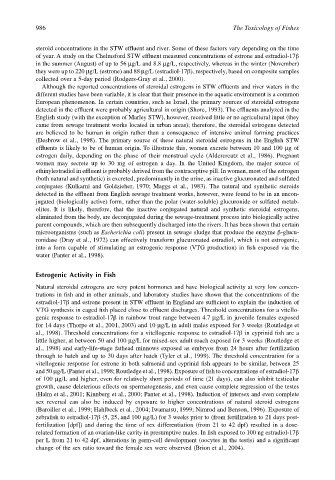Page 1006 - The Toxicology of Fishes
P. 1006
986 The Toxicology of Fishes
steroid concentrations in the STW effluent and river. Some of these factors vary depending on the time
of year. A study on the Chelmsford STW effluent measured concentrations of estrone and estradiol-17β
in the summer (August) of up to 56 µg/L and 8.8 µg/L, respectively, whereas in the winter (November)
they were up to 220 µg/L (estrone) and 88 µg/L (estradiol-17β), respectively, based on composite samples
collected over a 5-day period (Rodgers-Gray et al., 2000).
Although the reported concentrations of steroidal estrogens in STW effluents and river waters in the
different studies have been variable, it is clear that their presence in the aquatic environment is a common
European phenomenon. In certain countries, such as Israel, the primary sources of steroidal estrogens
detected in the effluent were probably agricultural in origin (Shore, 1993). The effluents analyzed in the
English study (with the exception of Marley STW), however, received little or no agricultural input (they
came from sewage treatment works located in urban areas); therefore, the steroidal estrogens detected
are believed to be human in origin rather than a consequence of intensive animal farming practices
(Desbrow et al., 1998). The primary source of these natural steroidal estrogens in the English STW
effluents is likely to be of human origin. To illustrate this, women excrete between 10 and 100 µg of
estrogen daily, depending on the phase of their menstrual cycle (Aldercreutz et al., 1986). Pregnant
women may secrete up to 30 mg of estrogen a day. In the United Kingdom, the major source of
ethinylestradiol in effluent is probably derived from the contraceptive pill. In women, most of the estrogen
(both natural and synthetic) is excreted, predominantly in the urine, as inactive glucuronated and sulfated
conjugates (Kulkarni and Goldzieher, 1970; Maggs et al., 1983). The natural and synthetic steroids
detected in the effluent from English sewage treatment works, however, were found to be in an uncon-
jugated (biologically active) form, rather than the polar (water-soluble) glucuronide or sulfated metab-
olites. It is likely, therefore, that the inactive conjugated natural and synthetic steroidal estrogens,
eliminated from the body, are deconjugated during the sewage-treatment process into biologically active
parent compounds, which are then subsequently discharged into the rivers. It has been shown that certain
microorganisms (such as Escherichia coli) present in sewage sludge that produce the enzyme β-glucu-
ronidase (Dray et al., 1972) can effectively transform glucuronated estradiol, which is not estrogenic,
into a form capable of stimulating an estrogenic response (VTG production) in fish exposed via the
water (Panter et al., 1998).
Estrogenic Activity in Fish
Natural steroidal estrogens are very potent hormones and have biological activity at very low concen-
trations in fish and in other animals, and laboratory studies have shown that the concentrations of the
estradiol-17β and estrone present in STW effluent in England are sufficient to explain the induction of
VTG synthesis in caged fish placed close to effluent discharges. Threshold concentrations for a vitello-
genic response to estradiol-17β in rainbow trout range between 4.7 µg/L in juvenile females exposed
for 14 days (Thorpe et al., 2001, 2003) and 10 µg/L in adult males exposed for 3 weeks (Routledge et
al., 1998). Threshold concentrations for a vitellogenic response to estradiol-17β in cyprinid fish are a
little higher, at between 50 and 100 µg/L for mixed-sex adult roach exposed for 3 weeks (Routledge et
al., 1998) and early-life-stage fathead minnows exposed as embryos from 24 hours after fertilization
through to hatch and up to 30 days after hatch (Tyler et al., 1999). The threshold concentration for a
vitellogenic response for estrone in both salmonid and cyprinid fish appears to be similar, between 25
and 50 µg/L (Panter et al., 1998; Routledge et al., 1998). Exposure of fish to concentrations of estradiol-17β
of 100 µg/L and higher, even for relatively short periods of time (21 days), can also inhibit testicular
growth, cause deleterious effects on spermatogenesis, and even cause complete regression of the testes
(Halm et al., 2001; Kinnberg et al., 2000; Panter et al., 1998). Induction of intersex and even complete
sex reversal can also be induced by exposure to higher concentrations of natural steroid estrogens
(Baroiller et al., 1999; Hahlbeck et al., 2004; Iwamatsu, 1999; Nimrod and Benson, 1996). Exposure of
zebrafish to estradiol-17β (5, 25, and 100 µg/L) for 3 weeks prior to (from fertilization to 21 days post-
fertilization [dpf]) and during the time of sex differentiation (from 21 to 42 dpf) resulted in a dose-
related formation of an ovarian-like cavity in presumptive males. In fish exposed to 100 ng estradiol-17β
per L from 21 to 42 dpf, alterations in germ-cell development (oocytes in the testis) and a significant
change of the sex ratio toward the female sex were observed (Brion et al., 2004).

